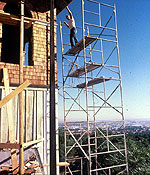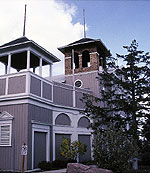Grant News
Colorado Chautauqua
Growing up in Boulder, I spent many summer afternoons watching fifty-cent matinees in an old auditorium in Boulder's Chautauqua Park. I can't recall any of the movies, but I do remember seeing dusty shafts of sunlight creeping into the theater through cracks in its deteriorating wood-frame walls when the lights dimmed. More than twenty years later, the Colorado Chautauqua Association (CCA), with support from the State Historical Fund, has restored the auditorium and several other historically and architecturally significant Chautauqua Park buildings as part of a comprehensive and ongoing preservation program.
As a youngster, I was unaware of the park's heritage. To me, it was a fun place with neat old buildings and a starting point for hikes among Boulder's signature landmarks, the Flatirons. To its founders and early twentieth-century visitors, the Colorado Chautauqua was something more: It was an educational institution, much like an informal university. The first Chautauqua, which offered cultural, religious, and recreational activities in a wooded lakeside setting, was established in New York in 1874. The concept of self-improvement in a resort atmosphere spawned similar institutions, and by 1900 there were hundreds of Chautauquas nationwide.
In 1898 Boulder civic leaders and Texas educators formed the Boulder Chautauqua on seventy-five acres at the base of Green Mountain overlooking the town. The auditorium, a dining hall, and hundreds of tents were erected before its July 4 opening celebration. Its object, according to the monthly Chautauquan, was to "provide a place where [people can go] for a few weeks outing, where they can…enjoy the advantages of a mountain climate, and return at the close of the season refreshed, invigorated, and altogether benefited both mentally and physically." Guests attended summer classes (adults chose from fifty-one courses), listened to the "brainiest platformists of the country," and enjoyed musical and theatrical entertainment. Orators delivered ninety-four speeches in the auditorium during the Chautauqua's first season. William Jennings Bryan-beloved in Colorado for advocating the free coinage of silver-was among the speakers in 1899. Building on its initial success, Boulderites replaced the tents with rustic cottages and constructed more public facilities, including an Arts and Crafts-style community house, two lodges, and an academic hall. In the 1930s, Boulder's Chautauqua survived while the Great Depression and America's changing recreational habits forced almost all of the nation's two hundred Chautauquas into bankruptcy. Today, just three of the original Chautauquas remain: the first educational resort in New York, another in Ohio, and the Boulder organization.
Since the late 1970s, the Colorado Chautauqua Association-with financial help from the State Historical Fund throughout the last decade-has committed itself to preserving the entire Chautaqua property. So far, the CCA has received grants totaling more than $570,000 and has rehabilitated and restored several buildings, including the auditorium, dining hall, academic hall, community house, and several lodges and cottages. Their long-term efforts have not gone unnoticed. In 1997 the CCA's preservation program received an Honor Award from the National Trust for Historic Preservation, and the Stephen H. Hart Award for excellence in historic preservation from the Colorado Historical Society. In addition to the CCA's staff and volunteers, the local community-including Historic Boulder, Inc., and the City of Boulder's Landmark Preservation Board-has been instrumental in realizing all of the Chautauqua preservation goals.
While the days of the fifty-cent matinee are long past, sunbeams still slip through repaired board-and-batten auditorium walls. Today, the auditorium is once again considered a top venue by musicians and orators who appreciate its superior acoustics and intimate, historic atmosphere.



